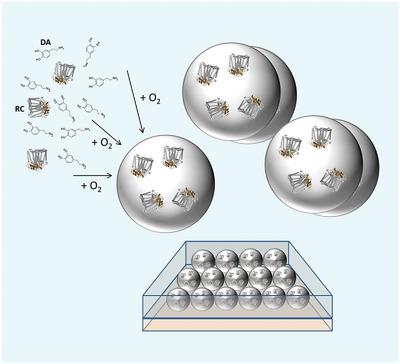当前位置:
X-MOL 学术
›
Adv. Electron. Mater.
›
论文详情
Our official English website, www.x-mol.net, welcomes your
feedback! (Note: you will need to create a separate account there.)
Photoelectrodes with Polydopamine Thin Films Incorporating a Bacterial Photoenzyme
Advanced Electronic Materials ( IF 5.3 ) Pub Date : 2020-05-20 , DOI: 10.1002/aelm.202000140 Marco Lo Presti 1 , Maria Michela Giangregorio 2 , Roberta Ragni 1 , Livia Giotta 3 , Maria Rachele Guascito 3 , Roberto Comparelli 4 , Elisabetta Fanizza 1 , Roberto R. Tangorra 1 , Angela Agostiano 1 , Maria Losurdo 2 , Gianluca M. Farinola 1 , Francesco Milano 4 , Massimo Trotta 4
Advanced Electronic Materials ( IF 5.3 ) Pub Date : 2020-05-20 , DOI: 10.1002/aelm.202000140 Marco Lo Presti 1 , Maria Michela Giangregorio 2 , Roberta Ragni 1 , Livia Giotta 3 , Maria Rachele Guascito 3 , Roberto Comparelli 4 , Elisabetta Fanizza 1 , Roberto R. Tangorra 1 , Angela Agostiano 1 , Maria Losurdo 2 , Gianluca M. Farinola 1 , Francesco Milano 4 , Massimo Trotta 4
Affiliation

|
A fabrication strategy of photoactive biohybrid electrodes based on the immobilization of the bacterial reaction center (RC) onto indium tin oxide (ITO) is proposed. The RC is an integral photoenzyme that converts photons into stable charge‐separated states with a quantum yield close to one. The photogenerated electron–hole pair can be eventually exploited, with suitable redox mediators, to produce photocurrents. To this purpose, RC must be effectively anchored on the electrode surface and simple strategies for its stable immobilization ensuring prolonged enzyme photoactivity are strongly desired. In this work, polydopamine (PDA), a polymer reminiscent of the natural melanin, is used to anchor the RC on the electrode surface. PDA is easily prepared in situ by spontaneous polymerization of dopamine in slightly alkaline aerated buffered RC solution. This reaction, carried out in the presence of an ITO substrate dipped into the solution, directly leads to a stable RC‐PDA/ITO photoelectrode with 20 nm film thickness and 50% of fully functional RC occupancy. Photocurrents densities recorded using this photoelectrode are comparable to those obtained with far more sophisticated immobilization techniques. The RC‐PDA films are fully characterized by visible–near‐infrared absorption spectroscopy, ellipsometry, atomic force, and scanning electron microscopies.
中文翻译:

带有细菌光酶的聚多巴胺薄膜的光电极
提出了一种基于细菌反应中心(RC)固定在氧化铟锡(ITO)上的光敏生物混合电极的制备策略。RC是一种不可或缺的光酶,可将光子转换为稳定的电荷分离态,量子产率接近于1。可以使用合适的氧化还原介体最终利用光生电子空穴对产生光电流。为此,必须将RC有效地锚定在电极表面上,并且强烈需要采用简单的策略对其进行稳定固定,以确保延长的酶光活性。在这项工作中,使用聚多巴胺(PDA)(一种类似于天然黑色素的聚合物)将RC锚定在电极表面上。通过在微碱性充气的RC缓冲溶液中多巴胺的自发聚合,很容易就地制备PDA。该反应在浸入溶液中的ITO底物的存在下进行,可直接产生稳定的RC-PDA / ITO光电极,其膜厚为20 nm,并且具有全部功能性RC占有率的50%。使用该光电极记录的光电流密度与采用更先进的固定技术获得的光电流密度相当。RC-PDA薄膜具有可见-近红外吸收光谱,椭偏,原子力和扫描电子显微镜等特征。使用该光电极记录的光电流密度与采用更先进的固定技术获得的光电流密度相当。RC-PDA薄膜具有可见-近红外吸收光谱,椭偏,原子力和扫描电子显微镜等特征。使用该光电极记录的光电流密度与采用更先进的固定技术获得的光电流密度相当。RC-PDA薄膜具有可见-近红外吸收光谱,椭偏,原子力和扫描电子显微镜等特征。
更新日期:2020-07-13
中文翻译:

带有细菌光酶的聚多巴胺薄膜的光电极
提出了一种基于细菌反应中心(RC)固定在氧化铟锡(ITO)上的光敏生物混合电极的制备策略。RC是一种不可或缺的光酶,可将光子转换为稳定的电荷分离态,量子产率接近于1。可以使用合适的氧化还原介体最终利用光生电子空穴对产生光电流。为此,必须将RC有效地锚定在电极表面上,并且强烈需要采用简单的策略对其进行稳定固定,以确保延长的酶光活性。在这项工作中,使用聚多巴胺(PDA)(一种类似于天然黑色素的聚合物)将RC锚定在电极表面上。通过在微碱性充气的RC缓冲溶液中多巴胺的自发聚合,很容易就地制备PDA。该反应在浸入溶液中的ITO底物的存在下进行,可直接产生稳定的RC-PDA / ITO光电极,其膜厚为20 nm,并且具有全部功能性RC占有率的50%。使用该光电极记录的光电流密度与采用更先进的固定技术获得的光电流密度相当。RC-PDA薄膜具有可见-近红外吸收光谱,椭偏,原子力和扫描电子显微镜等特征。使用该光电极记录的光电流密度与采用更先进的固定技术获得的光电流密度相当。RC-PDA薄膜具有可见-近红外吸收光谱,椭偏,原子力和扫描电子显微镜等特征。使用该光电极记录的光电流密度与采用更先进的固定技术获得的光电流密度相当。RC-PDA薄膜具有可见-近红外吸收光谱,椭偏,原子力和扫描电子显微镜等特征。











































 京公网安备 11010802027423号
京公网安备 11010802027423号